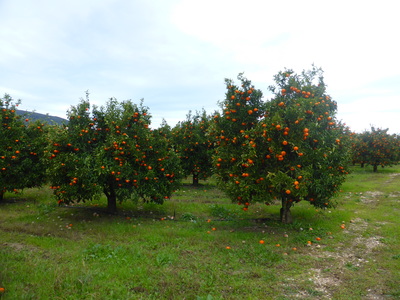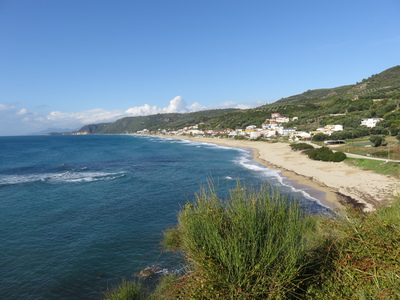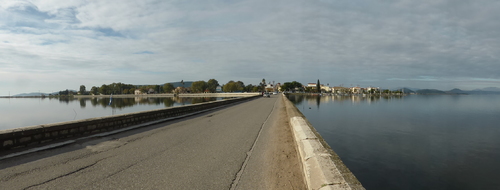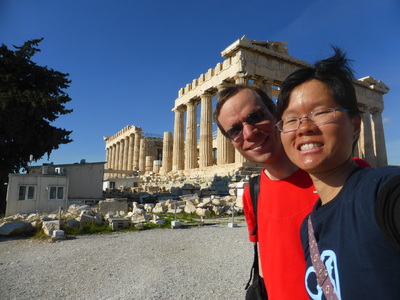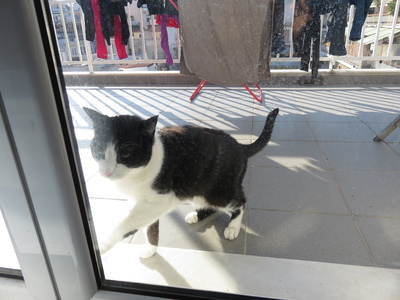Christmastime in Greece
Posted on 2019-01-03
We cycled along the Ionian Sea from the Albanian border to Patras. The first night, we camped between some orange plantations. We were surprised by the number of orange plantations we saw immediately after entering the country. It was nearing Christmas, and we thought the trees looked a bit like decorated Christmas trees 😉.
After Parga, we cycled down to a really nice stretch of beach that had been mostly abandoned for the winter. The road hugged the sea and it was fantastic riding while it lasted, for a few km. The road looked fairly flat on our map, but in fact there were a number of steep hills we had to cross in between the beaches. To top it off, shortly before we would leave the beach road, it was blocked by a construction site. We tried to bypass it through a muddy patch, but immediately became stuck there as the mud was so sticky that it firmly clogged up our wheels. After freeing the wheels enough to be able to cycle again, we were so exhausted that we decided to call it a day and booked the nearest Airbnb we could find. There, we spent another hour cleaning the rest of the mud off the bicycles. Tired and hungry, we went into the town centre looking for a supermarket, but it was closed. In fact, the whole town seemed dark and deserted, except for a few restaurants on the coast. Thankfully, after some search, we finally managed to find a minimarket.
The next day, to catch up with our plan, we cycled almost 90km around the Ambracian Gulf to Amfilochia, where Hannah had arranged to stay in the unoccupied house of a friend. From Amfilochia, we continued south through some nice landscapes and passed by the archaeological site of Stratos, where we stopped to have a look around the ruins. This was the only archaeological site we visited before Athens, despite seeing signboards for countless other sites along the way.
Temple of Zeus-Stratios in the archaeological site in Stratos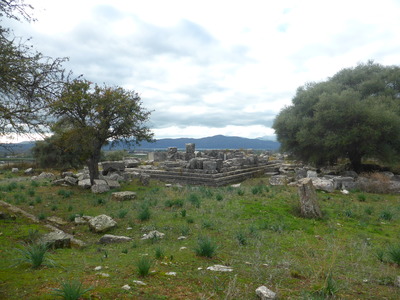
We found another nice place to wild camp a while later. The next day, we stumbled upon Aitoliko, a tiny island town in the middle of a lagoon. From there, we followed a scenic route close to the coast, to an impressive new bridge to Patras across the mouth of the Gulf of Corinth.
Road leading down to the Rio-Antirrio bridge to Patras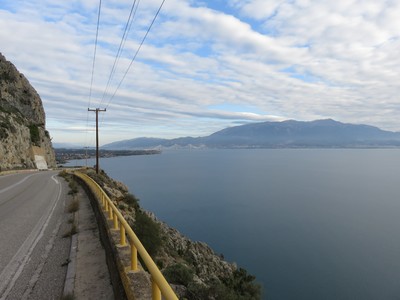
We took a rest day in Patras and spent some time exploring the city. We then turned eastward, following the southern coast of the Gulf of Corinth. Again, the road hugged the scenic coast for most of the way, although our attempts to stay as close to the coast as possible ended once at an impassable river ford. Otherwise, it was very smooth riding all the way to the Corinth Canal, which cuts across the narrow piece of land that connects the Peloponnese peninsula to mainland Greece. Instead of using sluices, a deep canyon was dug for the canal, creating an impressive sight from the bridges across it.
View of the Corinth Canal from the road bridge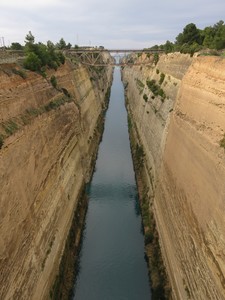
At this point, we were desperately in need for a longer, proper break, so we took the suburban train to Athens, where we stayed for almost a week. There, we finally had the time to shop for some essential items and maintain our bicycles and equipment. Of course, we also saw the Acropolis and most of the other main sights of Athens. But we also spent a good amount of time chilling out in our nice Airbnb apartment, baking Christmas cookies, planning the next leg of our trip, and playing with the neighbour's cat.
From Athens, we planned to take the ferry to Turkey. There are no direct ferries. Instead, one has to first take a ferry to one of the Greek islands close to Turkey, and then take another short ferry across the border. After considering the routes and schedules, we decided to stop over on Lesvos island, where we had a day to explore the area around the capital Mytilene, a cosy town with Christmas music playing on the public loudspeakers everywhere.
Mytilene town on Lesvos island
It may be hard to imagine, but this beautiful island currently houses the largest refugee camp in Greece, Moria camp, that according to many sources is in abysmal condition: overcrowded (housing three times its capacity), violent, and awash with waste. We went to Moria, but only to see the impressive ruins of the Roman Aqueduct there. After a short cycling loop across the eastern tip of Lesvos, it was time to catch the ferry to Turkey.
